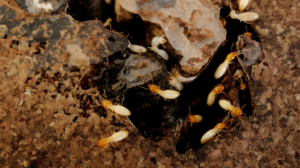Each summer, people head outside to enjoy the beauty of nature, the warming glare of the sun on the skin, the sights of butterflies fluttering in the wind, and a warm light breeze in the face, and most of the time, have to deal with the nuisances of mosquitoes and bees. But most people don’t think about ticks until a chance encounter brings them to mind.
The three most common species of ticks found in the U.S. are the American dog tick, black-legged tick (deer tick) and the lone star tick. All ticks go through the same life cycles, starting as an egg, then becoming a six legged larva, an eight legged nymph and finally, an eight legged adult. Different tick species reside in uniquely different habitats, ranging from grassy areas to forests.
Ticks are blood feeders, just like mosquitoes, which means they must find an host, take a bite, and then drink their meal. Ticks seek out a host by hanging on to a blade of grass with their rear legs and holding their front legs aloft, waiting for something to come along so they can attach themselves to the furs of animals or the clothes of people who walk by.
Ticks can be carriers of certain disease pathogens which includes the most common Lyme disease, which is transmitted by the black-legged/deer tick, Rocky Mountain Spotted Fever transmitted by the American dog tick, and Erhlichiosis Heartland Virus transmitted by the lone star tick. However, ticks can only transmit these diseases after feasting off the host for at least 24hrs. The best way to prevent these illnesses is to prevent ticks getting on you.
1. If you are going to be spending a great amount of time in wooded areas or amongst tall grasses, it is advisable to wear long pants, long sleeved shirts, and closed toed shoes. Wearing light colored clothing will make it easier to spot ticks.
2. To keep your yard tick free, keep your grasses cut low an d remove weeds, wood piles and debris which can attract ticks and other pests. Keep shrubs, bushes and other vegetation well pruned, particularly around the house and play areas. Wear a bug spray containing at least 20 percent DEET or permethrin when outdoors. Apply and reapply as instructed on the label. Also use landscaping that deters mice, deer, woodchucks and other rodents that carry ticks.
3. Wear a bug spray containing at least 25 percent DEET when outdoors. Apply them on your children and pets as they go out to play in the woods or on the grass. Avoid spraying them in the eyes and other sensitive parts of your body.
4. When walking, jogging or taking a hike, stay on the center of the trails, away from vegetation where they may be hiding and waiting to hitch a ride.
In addition, avoid walking your dogs in tall grasses where fleas and ticks often hide. Inspect your kids and pets for ticks on a routine basis, preferably after each day’s walk. Just like humans, pets can contact Lyme disease from ticks.
These steps should enable you enjoy a summer without having to worry about ticks attaching themselves to your kids or your pets.









